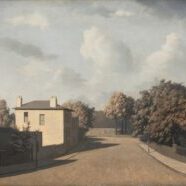Algernon Newton was born in Hampstead in 1880, a grandson of Henry Newton, one of the founders of Winsor & Newton, the art materials company.
Newton’s painting ‘Downshire Hill’, Hampstead captures a moment in the early 20th century when many of the buildings on Downshire Hill were a little more than a century old. Painted in 1934, it depicts the north-eastern end of the road with the former Freemasons Arms and entrance to Hampstead Heath.
The painting is available to view at Abbott and Holder and will be on display at London Art Week exhibitors showcase at Cromwell Place from the 28th June – 9th July.
Click on images for more information.
The location shown in the painting is the northeast end of Downshire Hill, as it runs down to the heath and shows the former Freemasons Arms before it was demolished in 1935. The photograph below is taken from roughly the same location.
As this painting is dated 1934, I suspect that Newton chose this view as he knew it would not be seen again once the old Freemasons Arms was demolished. Newton’s daughter, Pauline Mary, married Basil Murray, whose brother Stephen lived at 25 Downshire Hill. It is, therefore, no coincidence that the position of Newton’s view is located almost exactly on the street outside number 25.
The original Freemasons Arms was built in 1819 and positioned on the road’s edge, slightly further toward the heath. It was a lively conglomeration of two disparate buildings, unified through Neo-Classical embellishment. The new Freemasons Arms, completed in 1936, was built abutting number 31 Downshire Hill. This smaller, lower building in the painting is the last house in the row on the left, in the space shown in Newton’s work occupied by the low wall.
Numbers 29 and 30 are shown on the left, along with their metal railings at first-floor level, which are still in place today.
Newton’s work is clearly foreshortened, showing the edge of the heath somewhat closer to the viewer. In reality, this is a little further off in the distance, but it provides Newton with the means to express a more expansive scene. This is a typical Newton composition, where atmosphere and architecture take precedence over human activity.
At the right-hand side of the painting is number 35 Downshire Hill, with number 36 disappearing into the shadows of the trees. Number 35 Downshire Hill was the former home of Margaret Gardiner, ‘a radical modern British patron of artists’ and in whose garden was once located “Curved Form (Trevalgan)”, a 1956 bronze sculpture by Barbara Hepworth, now in the Pier Art Centre in Stromness, Orkney Islands.
From the same vantage point on Downshire Hill, 107 South End Road occupies a dominant position at the end of the street. However, in Newton’s artwork, it simply isn’t shown. From a photograph taken in the early 1950s showing paille maille players in the garden of the Freemasons Arms, the houses along South End Road are clearly visible in the background. Number 107, closest to the photographer, shows the building as it was in the early 1950s. This is how Newton would have seen this property, hidden behind a row of trees that he has faithfully reproduced leading to the edge of the heath. 107 South End Road was extensively remodelled in the late 1950s.
Downshire Hill, at the junction of Willow Road and South End Road, is sometimes windy, the breeze coming down off the heath toward South End. You get a sense of this in his painting. This is especially so in the way he has depicted the willow trees (the original trees along this street gave Willow Road its name) behind the Freemasons Arms, which sadly have now gone.
Judging by the light and shadows, Newton has depicted the street in the late afternoon as the houses on the north-eastern edge of the street fall in shadow at around 3 pm. I also presume this was painted in early summer, as all the trees are in full leaf. This would suggest that the Freemasons Arms was facing its last days; Newton has even painted the windows in a way that seems to suggest they are boarded up.
It is a wonderfully atmospheric work, capturing a scene that would shortly be lost forever. I am sure Newton knew this as he was so good at painting those parts of London that faced imminent extinction. It is always about the place with Newton rather than the people, and this image is no exception. It places the emphasis squarely on the Freemasons Arms, the single lonely person depicted in the painting, walking away from it, the winds of change blowing across its elevation.
If you would like to view ‘Downshire Hill’, Hampstead, please contact Tom Edwards at Abbott and Holder.
Abbot and Holder
30 Museum Street
London, WC1A 1LH
[email protected]
Tel: 020 7637 3981
